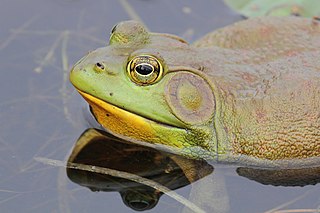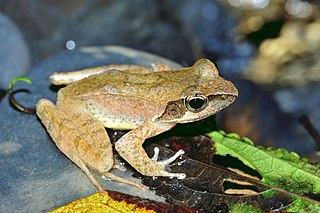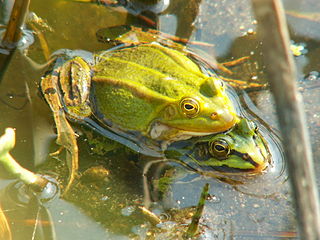
Gekko is a genus of Southeast Asian geckos, commonly known as true geckos or calling geckos, in the family Gekkonidae. Although species such as Gekko gecko are very widespread and common, some species in the same genus have a very small range and are considered rare or endangered. Fossils, including Yantarogekko, date back to the Eocene.

Luperosaurus is a genus of lizards, commonly known as camouflage geckos, fringed geckos, wolf geckos, and flap-legged geckos, in the family Gekkonidae. The genus is native to Southeast Asia.

Parvoscincus is a genus of skinks, lizards in the family Scincidae. The genus is endemic to the Philippines.

Rana is a genus of frogs commonly known as the Holarctic true frogs, pond frogs or brown frogs. Members of this genus are found through much of Eurasia and western North America. Many other genera were formerly included here. These true frogs are usually largish species characterized by their slim waists and wrinkled skin; many have thin ridges running along their backs, but they generally lack "warts" as in typical toads. They are excellent jumpers due to their long, slender legs. The typical webbing found on their hind feet allows for easy movement through water. Coloration is mostly greens and browns above, with darker and yellowish spots.

Platymantis is a genus of frogs in the family Ceratobatrachidae. They are commonly known as wrinkled ground frogs, ground frogs, and forest frogs.

Lithobates is a genus of true frogs, of the family Ranidae. The name is derived from litho- (stone) and the Greek bates, meaning one that treads on rock, or rock climber.

Rana amurensis is a species of true frog found in northern Asia. It ranges across western Siberia, as well as northeastern China, northeastern Mongolia, and on the northern Korean Peninsula and on Sakhalin. Rana coreana was previously included in this species as a subspecies. Found at latitudes up to 71° N, it is the northernmost wild amphibian species.
The Cabalian frog or Leyte slender stream frog is a species of frog in the family Ranidae. It is endemic to the islands of Leyte, Samar, and Mindanao in the Philippines. It inhabits undisturbed and disturbed streams and rivers in lower montane and lowland forests. It is threatened by habitat loss through deforestation and habitat conversion to agriculture as well as by the pollution due to agricultural run-off.

The common green frog is a frog species of in the true frog family Ranidae; some sources still use the old name Rana erythraea. It lives in Southeast Asia and is also known as green paddy frog, red-eared frog or leaf frog. The last name, however, commonly refers to the Neotropical tree frogs which make up the subfamily Phyllomedusinae. These are not closely related to H. erythraea, belonging to family Hylidae instead.

Rana sauteri is a species of true frog endemic to Taiwan. It inhabits low-altitude hill forests and the associated streams. It is an endangered species threatened by habitat loss due to agriculture and infrastructure development. Common names recorded for Rana sauteri include Kanshirei Village frog, Taiwan groove-toed frog, Sauter's brown frog, and Taiwan pseudotorrent frog.

Sanguirana sanguinea is a species of frog in the family Ranidae. It is found in Sulawesi, Indonesia and Palawan, the Philippines.

Eutropis is a genus of skinks belonging to the subfamily Lygosominae. For long, this genus was included in the "wastebin taxon" Mabuya; it contains the Asian mabuyas. They often share their habitat with the related common skinks (Sphenomorphus), but they do not compete significantly as their ecological niches differ.

Pelophylax is a genus of true frogs widespread in Eurasia, with a few species ranging into northern Africa. This genus was erected by Leopold Fitzinger in 1843 to accommodate the green frogs of the Old World, which he considered distinct from the brown pond frogs of Carl Linnaeus' genus Rana.

The Ceratobatrachidae are a family of frogs found in the Malay Peninsula, Borneo, the Philippines, Palau, Fiji, New Guinea, and the Admiralty, Bismarck, and Solomon Islands.

Sanguirana igorota is a species of true frog, family Ranidae. It is endemic to Cordillera Central of the island of Luzon, Philippines. Its closest relative is Sanguirana luzonensis, and it has even been considered synonym of that species; a later study suggests still unresolved relationships between S. igorota, S. luzonensis, and S. tipanan. Common name Taylor's Igorot frog has been coined for this species.

Alcalus is a small genus of frogs in the family Ceratobatrachidae. It is the only member of the subfamily Alcalinae. Its sister taxon is Ceratobatrachinae. Common name Alcala's dwarf mountain frogs has been proposed for the genus. They are found in Palawan Island, Borneo, and the Malay Peninsula. They prefer semi-aquatic microhabitats.
Cornufer is a genus of frogs in the family Ceratobatrachidae. It has been greatly expanded by Brown, et al. (2015) to include most Australasian frogs in the family Ceratobatrachidae. Species are found in Melanesia and Polynesia — in Palau, Fiji, New Guinea, and in the Admiralty, Bismarck, and Solomon Islands.

The Cyclocorinae are a subfamily of lamprophiid snakes endemic to the Philippines. It was erected in 2017 to house 4 enigmatic, endemic genera containing 7 species and one undescribed lineage that are more closely related to one another than to members of the subfamilies Atractaspidinae and Aparallactinae or to other subfamilies of Lamprophiidae. Previously placed within Colubridae, a 2017 study by Weinell et al. found strong support the monophyly of Cyclocorinae within Lamprophiidae, but its position relative to the other subfamilies of Lamprophiidae is not resolved. Cyclocorinae was found to be a possible sister group to Atractaspidinae. Despite high support for a close relationship from DNA, there are no unambiguous morphological characteristics that unite these four genera. A fifth genus, Levitonius, was described in 2020.

Tytthoscincus is a genus of skinks. Originally defined to include a few species from the Philippines, the genus now includes many species from South-East Asia in general.

















